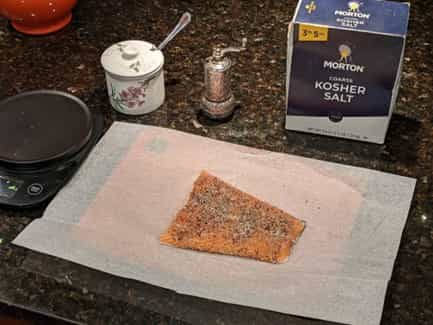
I love cured meats of all types: hot smoked ham, prosciutto, bresaola, cured salmon, all manner of dried salumi. It’s my intention to walk you through the many types of cured meats you can make at home without a drying chamber. If you’ve got a scale, a fridge, and an oven there are a huge number of curing projects available to you, and even more if you’ve got a smoker!
We’re going to start with the easiest one of all, cured salmon. In addition to how simple it is to cure salmon at home, it’s also the one that will save you the most money when you’re hosting brunch.
Here’s what you’ll need:
- Salmon (skin on is best)
- Salt
- Sugar
- Scale
- Ziploc bag, plastic wrap or parchment paper
 This recipe is measured in weight. I will not be providing volumetric measurements because they are not precise enough to produce a consistent product. I’m making a small amount here, but this recipe will work for an entire side of salmon
This recipe is measured in weight. I will not be providing volumetric measurements because they are not precise enough to produce a consistent product. I’m making a small amount here, but this recipe will work for an entire side of salmon
First, thaw, rinse, and pat dry the salmon. Then make the cure. The base for this cure is simply salt and sugar. You can add anything you want to it to add flavor. I’ve done gin, dill and lemon, shredded beet, pastrami seasoning, etc. Get creative! I’m keeping it simple today with plain black pepper.
To make the cure, start by weighing the salmon. For those of you savvy with baker’s math, we’ll be using a cure of 2.5% salt and 1.5% sugar. For those of you who aren't, let me explain. The percentage is relative to the total weight of the meat. It is not 2.5% of the final product. What that means for us is that the math is super easy! Today’s salmon weighed in at 205g.
205 x 0.025 = 5.1g - that's how much salt we’ll need. 205 x 0.015 = 3.1g of sugar. Mix the salt, sugar, and anything else you’re using for flavor.
 Coat the meat. Cover every part of exposed salmon using the entire mixture. No need to salt the skin. After the salmon is salted, there are a few ways to close it up. A Ziploc bag works, a vacuum sealer works better. I like to use parchment paper because it allows a small amount of moisture to evaporate leading to a firmer final product. Place the wrapped fish between a plate and something flat like a cutting board with some weight on top. This step isn't strictly necessary, but it helps get that classic cured salmon texture. Leave it in the cure for 24 to 48 hours. Because we have the correct final amount of salt and sugar, we don’t have to worry about timing.
Coat the meat. Cover every part of exposed salmon using the entire mixture. No need to salt the skin. After the salmon is salted, there are a few ways to close it up. A Ziploc bag works, a vacuum sealer works better. I like to use parchment paper because it allows a small amount of moisture to evaporate leading to a firmer final product. Place the wrapped fish between a plate and something flat like a cutting board with some weight on top. This step isn't strictly necessary, but it helps get that classic cured salmon texture. Leave it in the cure for 24 to 48 hours. Because we have the correct final amount of salt and sugar, we don’t have to worry about timing.

 The next day, unwrap your cured salmon, rinse, pat dry, and slice! Using your sharpest knife, slice at a very low angle in the direction of the tail. Once you’ve sliced enough for brunch, it’s time to enjoy it on one of Chef Max's homemade bagels!
The next day, unwrap your cured salmon, rinse, pat dry, and slice! Using your sharpest knife, slice at a very low angle in the direction of the tail. Once you’ve sliced enough for brunch, it’s time to enjoy it on one of Chef Max's homemade bagels!
 If you’re interested in smoking your salmon, simply smoke it anywhere from 4 to 24 hours reaching a temperature no higher than 100f. You can also cheat by adding some liquid smoke to the cure!
If you’re interested in smoking your salmon, simply smoke it anywhere from 4 to 24 hours reaching a temperature no higher than 100f. You can also cheat by adding some liquid smoke to the cure!
If you really want to impress your brunch guests, give them homemade bagels to eat with your cured and/or smoked salmon, and learn how to do a quick hot smoke on the fish. Get all of these techniques in our Hands-On Bagel Brunch on Saturday, March 16 at 11am at Lincoln Square. You'll make:
- Homemade Bagels with Hot-Smoked Salmon and Herb Cream Cheese
- Cucumber-Dill Salad
- Cheesy Hash Brown Casserole

